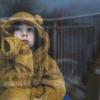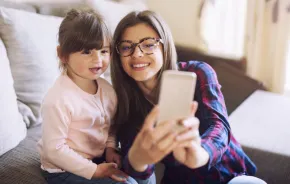
Cofounder of Hollow Earth Radio, Amber Kai Morgan is a teaching artist currently involved in reinventing The Makery, an all-ages mobile art lab. A former Montessori creative arts teacher, she has designed learning programs for FamilyWorks Resource Center and community-based radio-play and field-recording workshops for youth through Hollow Earth Radio. In 2014, Morgan was nominated for one of The Stranger’s Genius Awards. She was also named in City Arts magazine’s 2011 Future List. Morgan is an actively exhibiting sound and installation artist and lives in Seward Park with her husband, Garrett Kelly, and their son, Ukiah.
You’ve recently transitioned from teaching full-time to codirecting The Makery. What does a mobile art lab do?
Since January 2015, Connie Jones Ostrowski, Kathy Quenzer and have I codirected The Makery. The Makery was a community project started four and a half years ago by Lily Hotchkiss, who hosted free monthly events and attended festivals and events to provide free-form, all-ages art experiences in South Seattle. We inherited an art truck from Lily that serves as storage for donated and reclaimed art materials. We’re expanding on Lily’s ideas and developing some new ones. Currently, we offer a free Make & Take art event at SEEDArts Studio in Hillman City on the first Sunday of each month. The Makery Art Birthday Party is a program we cocreate with families to provide art-making activities customized to the child’s age, interest and party theme, if there is one. We bring our art lab and truck of ideas, recycled materials and inspiring art projects to the party. We can do these parties for adults, too! We have two art camps in August at the Lakewood Community Center in Seward Park and are developing weekly classes for various ages that we plan to start this summer in South Seattle. We’re incubating some top-secret ideas that involve crafting. Ultimately, we’d love to have a permanent location in South Seattle that would serve as an art studio for classes, camps, art clubs and parties.
Even before you became a mom, much of your work was rooted in creating educational opportunities for young people. How did you come to focus your efforts on youth?
I grew up in south Georgia on a plot of 60 acres that roughly six families shared. Trails led to each family’s houses and gardens. There was a pyramid for growing alfalfa sprouts and a Japanese kiln, creeks and alligators, snakes and dogs, cats and horses, and a shared tractor among us all. There were about eight children living there. I went home recently and talked with a neighbor about my childhood. She recalled me being “the teacher” of all the kids. I had them do projects and drawings, even though I wasn’t the oldest. I always gravitated toward working with kids. I knew that would be my focus when I got a social work degree. Even when I stepped into the world of creating Hollow Earth Radio, I had the goal of sharing radio with kids.
How has teaching in a Montessori environment had an impact on your educational philosophy?
I love the way the Montessori environment is set up with the child in mind. It is meant to be beautiful while also being practical and relevant to the child, so that they can be independent and choose projects that intrigue and motivate them. I was inspired by teaching children how to use all sorts of art tools, so that they can create their own art projects and know how, where and when to use the tools. I love preparing an environment with beautiful materials. It makes me really happy, and I think it makes the kids happy, too, when they see beauty and are able to freely work with the materials and learn that they are artists during this process. Creating art for the pure joy of self-expression is important in a Montessori environment. The process is what fuels a child to find their own expression.
Tell me about your attraction to repurposing materials.
I like digesting a thing — a material or a sound, even an idea. I think about all the ways it could be layered or added to something else. It’s comforting to go through a thing’s full potential to think about all the possibilities.
There was an artist, Paul, who lived on the land where I grew up, in a temporary structure that he built next to my neighbor’s garden. He would gather all the kids to do art projects and teach us how to make collages and gather found objects from nature and incorporate them into decorations for the garden. I consider him pretty influential.
I like digesting a thing — a material or a sound, even an idea. I think about all the ways it could be layered or added to something else. It’s comforting to go through a thing’s full potential to think about all the possibilities.
I’m always telling Garrett to save plastic caps, seltzer six-pack rings or cereal boxes so they can be used to make robots or whatever. I spotted some prime boxes at my acupuncturist’s office a few years ago. I swayed her into saving them for me on an ongoing basis so I could make Year of the Snake sculptures with kids. I get everyone in on it.
Art should be accessible. Recycled materials fit with this value. The Makery recently worked with [Seattle Department of Transportation] to host a Play Street event with art activities that could be done at a very low cost. Art made with reclaimed stuff is just as relevant, beautiful and fun.
You and your husband, Garrett, have collaborated on several projects. What’s it been like working together?
Garrett was intrigued by collecting answering machine tapes and tape letters and recorded meetings on tapes from thrift stores, and I joined him in that hobby. We put out an album of found sound and used the found sounds to layer in sound collages as we DJ-ed at art museums and galleries around town.
It was exciting to create Hollow Earth Radio together, and also challenging to work together and be in a relationship. The radio was in our house for four years! I put a moratorium on radio talk while eating dinner. I also started recording Garrett answering his phone on our dates to offer technical support to DJs. There are a lot of recordings of him saying things like “Is it plugged in?” and “Is the volume turned down on the computer?”
We got married in 2012, after running the radio together for six years. One of our dear friends who had been a board member gave the toast. He started off by saying to the entire wedding audience, “Have you seen these guys argue? It’s intense. They totally disagree on a lot of things. Then, all of a sudden, it’s over, and they’re laughing and have moved on to the next thing, and I am sitting in awe that they moved through it all with a resolution so quickly.” That’s how it is for us to work together.











